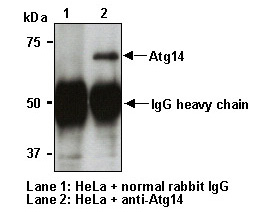Antibody detailed product information
| Code No. | PD026 | |
| Anti-Atg14 pAb | ||
| Size | 100 µL | |
| Availability (in Japan) | 10 or more
(In Japan at 00:05, Apr 26, 2024 in JST) |
|
| Clonality | Polyclonal | |
| Clone | Polyclonal | |
| Isotype (Immunized Animal) |
Rabbit Ig (aff.) | |
| Applications | WB 1:500 IP 5 µL/300 µL of cell extract from 3 x 106 cells IC* reported. (PMID: 24705551) |
|
| Immunogen (Antigen) |
Recombinant Human Atg14 (167-404 a.a.) | |
| Reactivity [Gene ID] | ||
| Storage buffer | PBS/50% glycerol, pH 7.2 | |
| Storage temp. | -20°C | |
| Conjugate | Unlabeled | |
| Manufacturer | MBL | |
| Alternative names | ATG14, autophagy related 14, ATG14L, BARKOR, KIAA0831/ Atg14L, 4832427M01, D14Ertd114e, D14Ertd436e | |
| Background | Autophagy is a process of intracellular bulk degradation in which cytoplasmic components including organelles are sequestered within double-membrane vesicles that deliver the contents to the lysosome/vacuole for degradation. Mammalian homologues of Atg14/Atg14L/BARKOR localizes on the isolation membrane and autophagosome, and it necessary for autophagosome formation. Atg14 binds to the PI3K complex (Beclin-1, Vps34, Vps15) and promotes the autophagosome formation. | |
| Related products | M184-3 Anti-Atg14 (Human) mAb PD017 Anti-Beclin 1 pAb MD-06-3 Anti-PI3-kinase (p85α) mAb M170-3 Anti-Rubicon (Human) mAb PD027 Anti-Rubicon (Human) pAb M160-3 Anti-UVRAG mAb PM072 Anti-VMP1 pAb |
|
| Product category | Research area:Autophagy | |
| Data |   |
|
| Citations | Western Blotting
Immunoprecipitation
Immunocytochemistry |
|
- The availability is based on the information in Japan at 00:05, Apr 26, 2024 in JST.
- The special price is shown in red color.
- Please note that products cannot be ordered from this website. To purchase the items listed in this website, please contact us or local distributers.
- Abbreviations for applications:
WB: Western Blotting, IH: Immunohistochemistry, IC: Immunocytochemistry, IP: Immunoprecipitation
FCM: Flow Cytometry, NT: Neutralization, IF: Immunofluorescence, RIP: RNP Immunoprecipitation
ChIP: Chromatin Immunoprecipitation, CoIP: Co-Immunoprecipitation
DB: Dot Blotting, NB: Northern Blotting, RNA FISH: RNA Fluorescence in situ hybridization - For applications and reactivity:
*: The use is reported in a research article (Not tested by MBL). Please check the data sheet for detailed information.
**: The use is reported from the licenser (Under evaluation or not tested by MBL).
- For storage temparature: RT: room temparature
- Please note that products in this website might be changed or discontinued without notification in advance for quality improvement.
 Copyright (C)2015 Medical & Biological Laboratories Co., Ltd. All Rights Reserve
Copyright (C)2015 Medical & Biological Laboratories Co., Ltd. All Rights Reserve